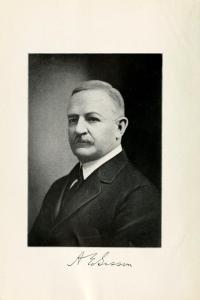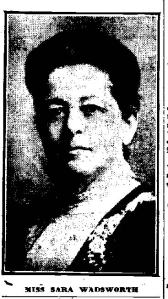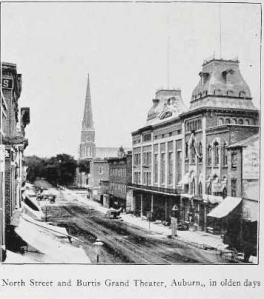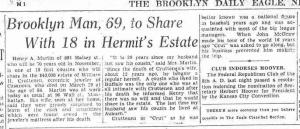A Note to My Readers: After some research on epidemiology with an eye on Auburn, New York at the turn of the last century, I decided to zero in on typhoid, cholera, consumption, Spanish Flu and infantile paralysis…with a side bar on malaria and diphtheria. During that period, a number of my family members were afflicted with at least one or more of these scourges and there were fatalities as well. Story after story unfolded in my research and it was unsettling to say the least that any one of these diseases could visit any household…any community and all folks could do was react and pray their efforts would spare their loved ones. Today we take for granted modern healthcare and public sanitation standards and the resulting protection due to prophylactic measures…vaccinations…water filtration, waste and trash disposal systems. We know it works, because it has for over a century. Today there are still those that deny scientific proof even in the face of solid evidence and history.
Last week I had worked on a blog post about civil engineering and Auburn’s history of street numbering, building its various infrastructures for water and sewer and electric. In trade journals spanning from 1909 and 1910, among the dry engineering specs, bids and contracts, I ran into a more prosy and intriguing reference to several plans and discussions about building a water filtration plant for Owasco Lake…Auburn’s main water supply at the time. And the typhoid debate.
It sparked a curiosity as over the Christmas holidays I had read a book entitled “The Epidemic” by award-winning journalist David DeKok which recounted the terrible typhoid epidemic in Ithaca, New York that devastated Ithaca in 1903. Typhoid infected hundreds and killed at least 82 people, including 29 Cornell University students. Almost 1 in 10 residents became ill. DeKok gives a chilling account of corporate greed and political disconnect that was the nexus of the catastrophe. DeKok’s detailed account illustrates clearly that the entire typhoid tragedy could have been avoided had a proper water filtration plant that should have been built. In fact the dam that was built without the accompanying filtration plant was the root cause due to the human excrement build up at the labor site by infected immigrant workers. Matters were further complicated with the failure of authorities to report the deplorable and dangerous conditions that they had found.
That was 1903. It was national news and certainly could not have escaped the attention of Auburn, New York. Typhoid regularly appeared, not just along the communities of Cayuga Lake, but Owasco Lake as well.
In 1909 and 1910 New York State led the nation in typhoid deaths. The United States was declared as having the most typhoid deaths of any civilized nation with 1300 deaths reported in the year of 1909. Newspapers were awash with reports of outbreaks and local health authorities testing waters and even milk. Municipalities across the country were building filtration plants to decontaminate the water and protect their populations. Still some communities resisted despite the evidence that others were now relieved of typhoid outbreaks by filtering the water and implementing other sanitation methods. There was no doubt that exposure to human excrement was the issue. Health officials had standardized instructions for individuals and hospitals managing an outbreak and it was up to the private citizen and the local doctors at hand to prevent it or enforce it. It was up to local governments to decide what was best for their community when it came to infrastructure investment. Like a water filtration plant.
Governor Hughes was urged by the State Department of Health to enact legislation to relieve “the water supplies of the State from pollution”.
“Many of our streams,” says the report, “have reached the amount of pollution they will care for. That such a condition of affairs exists is a public disgrace. But little relief in the conditions can be obtained under the existing laws.”
Summer resorts were especially unhealthful due to methods of sewage disposal as the report advised. Added to that problem was the fact that summer people from other communities brought typhoid with them. “The conditions of a number of places have been found to be dangerous to the persons visiting them.”
Another factor came into play as well. Just as it happened in Ithaca, newly arrived European immigrant laborers, brought typhoid with them. As New York State’s cities were expanding, large contractors – many of them New York City firms- bid on the municipal projects in great competition and brought in cheap labor to win bids by keeping costs down. Newly arrived immigrants fit the bill. The laborers had been exposed for years and had immunity and so they were carriers. As the children’s book says…”Everybody Poops”. And this was still the era of outhouses and wells. Public and private. Especially along the lakes. Auburn may have installed sewers and there was indoor plumbing, but there were still private and public wells and private…um…privies.

In 1910 though the evidence and statistics gathered by respected experts of the day overwhelmingly pointed to the conclusion that a water filtration plant was the answer to Auburn’s typhoid outbreaks, some of the officials and elite citizens of Auburn had a curious resistance and furious public debate had begun. I say curious because despite the fact that “BOIL THE WATER” was the order of the day and the naysayers themselves enthusiastically complied, a water filtration system seemed to be an absurd idea to them.
Moravia and Union Springs were particularly hard hit in October of 1910. Whole families were devastated. The Gillespie family of Basin Street in Union Springs lost their fifth member in three weeks with the death of 25 year old Joseph. His mother and three brothers had perished during the late days of September. Brothers Bernard and Thomas died within minutes of one another. Father James lie on his death bed. Mother Bridget Gillespie contracted typhoid while caring for her ill sons and lived only a short time. Only three Gillespie daughters were spared. Frightened by the swiftness of the family’s demise, a petition to the State Board of Health was circulated by Reverend W. H. Casey pleading for assistance for a remedy.
Their neighbors…the Tierneys – Hattie and her brother – also lay critically ill with the fever.
In Moravia townspeople were instructed to boil their water and five springs southeast of the village were found to be the suspected sources. Specific instruction given by Moravia’s Board of Health ranged from the proper supervision of the milk supply to the isolation of patients and disinfection methods. Sears and Ingalls Springs were immediately protected against contamination. The spring near Skinner Mill road was ordered to be abandoned.
Moravia’s citizens had just suffered a series of typhoid outbreaks of note in the previous years. The very same health officials had answered that call for help, including Dr. M. P. Conway, Head of the Water Board. In that year the measures seemed to revolve around containment of the ill and dying and debating about the source.
Got Milk? Got Typhoid?
It was noteworthy that in 1908 the Water Board headed by President M. P. Conway took public issue with the theory of Health Officer Dr. A. H. Brown and which had been endorsed by Dr. Thomas Darlington, Health Commissioner of Greater New York, to the effect that “the typhoid germs came down 14 miles from Moravia to the mains of the this city (Auburn)”. Dr. Conway pronounced the opinion as “rot”. Politics played itself out as Conway and Brown’s divergent and heated opinions found themselves in public discourse at city meetings and in newspaper articles. The Health Department and Dr. Conway had had run- ins before. When Auburn was hit in March of 1907, it was said that source of the contagion was “still shrouded in mystery. The Health department insists that it is the water supply that is at fault and the Water department insinuates that it is the milk supply.” Cayuga County Dairy Company’s milk was tested and though a small trace was found, it was declared ‘good milk’, but that the pasteurizing was not quite adequate. So they tested the water. It was contaminated, but not with sufficiently high enough levels to convince everyone that the lake was the likely source. As I discovered in further reading, if the samples are not taken at the correct site of contamination, a low count will be the result. Further field samples taken in a variety of locations did reveal higher counts.
 Drs. Brown and Darlington spoke at the First Presbyterian Church in May of 1908 ‘to speak of local conditions and work of sanitation in Auburn.” The main topic presented was “The White Plague”. Consumption. Tuberculosis. Lectures were delivered by physicians and exhibits educated Auburnians on this ever present and real threat. But the doctors weren’t done with the subject of Typhoid. Not when year after year, outbreaks were sickening and killing so many. In an impressive presentation supported by research and facts on the outbreaks, Dr. Brown made it undeniably clear that the contamination was in the water and due to insufficient sanitation. He cited Ithaca’s unfortunate history and declared that
Drs. Brown and Darlington spoke at the First Presbyterian Church in May of 1908 ‘to speak of local conditions and work of sanitation in Auburn.” The main topic presented was “The White Plague”. Consumption. Tuberculosis. Lectures were delivered by physicians and exhibits educated Auburnians on this ever present and real threat. But the doctors weren’t done with the subject of Typhoid. Not when year after year, outbreaks were sickening and killing so many. In an impressive presentation supported by research and facts on the outbreaks, Dr. Brown made it undeniably clear that the contamination was in the water and due to insufficient sanitation. He cited Ithaca’s unfortunate history and declared that
Auburn’s typhoid outbreak was caused by the epidemic in Moravia. During the spring thaw, the ice that was melting and came down the inlet from Moravia was tested and it had the highest bacterial count they had ever witnessed.
The fact that in 1916 a water filtration plant was planned and in 1918 contracted to build for Owasco Lake leads me to believe that the good doctor’s conclusions were most definitely not “rot”. Eventually, the pressing proof had the Water Board allied with Dr. Brown in the ongoing drive to establish a new water filtration plant.
Experts continued to push municipalities at the national, state and local levels to purify municipal water sources. A movement was underway, filtration plants bloomed everywhere and soon the levels of disease fell dramatically. Still Auburn didn’t quite buy in. The new debates revolved not around the source of the disease, but rather what water plant would work best and who was in control of the water plant. A good number of the cities that had built new plants were located on rivers and it was thought that lake water and river water had differing issues.
The Chickens Have Come Home to Roost
More debate over the next few years continued, but as knowledge improved and more filtration systems were installed, the idea of a water plant was becoming acceptable. The debate topics changed. It was no longer ‘should we build’. Instead the issue went to the manner of raising money and just how to convince citizens to approve the water treatment plant. Politics had muddied the waters so to speak. Questions whirled about the community. What were the available designs that would work best and what were the cost comparisons for building one? What kind of life would it have and what would the ongoing maintenance needs be? How would rates be controlled? Everyone had an opinion and everyone had a stake in it. Politicians and respected leaders worried about who had authority over the fundraising. It was thought that the Water Board did not have the legal authority to implement the fundraising and in fact, the Water Board was labeled as reckless. It was recommended that the citizens should vote on whether or not to build the plant.
“The Water Board’s financial chickens are soon coming home to roost,” declared Democratic candidate for Member of Assembly, Thomas M. Osborne.
In his 1910 campaign speech at a large political meeting held at the Court house, Mr. Osborne spoke on many subjects to the crowd which filled the rooms from wall to wall and overflowed into the hallways. When he arrived fresh from a speech at Owasco, the crowd hooped and applauded. Quieting the crowd, he narrated the history of the Water Board, pointing out its financial weaknesses and failures. He went on to state that its refusal to be a coordinated member of city government left in doubt its ability to manage the bonds and the water rates to any satisfaction. Osborn called out the President of the Water Board, M. P. Conway.
“Calling attention to the fact that the President of the Water Board had pronounced as “rot” the theory several years ago that typhoid germs could be carried from… carelessly supervised by the Water department of Moravia, Cascade and other places…”
Osborne went on to allege that the President of the Water Board’s fixation on milk being the source of the typhoid epidemic was because Osborne was interested in the Cayuga County Dairy Company. Wrapping up that portion of his speech, he stated that he was not opposed to the water filtration plant and declared that the plant proposed by the Water Board was not sufficient for the city of Auburn.
Pending the necessary reorganization of the Water Board and its being brought into proper relation to other city departments he urged the defeat of the filtration plant scheme.
After several years of debate and active campaigning, on November 7, 1916, the citizens of Auburn voted in favor of the new water filtration plant.
At the heart of the contention was money and control. Should the monies involve raising taxes? Assessing property owners? The history of the Water Board and its handling of bonds made people nervous. Women property owners were furious because they did not yet have the vote at that time and they wanted a say. Suffragettes were out in force. But something had to be done and when the politics settled down, the public good was the bottom line and a financing strategy was determined. It was time.
In 1917 as requested by the Water Board, Auburn’s City Alderman passed a resolution for Issuance of $200,000 in bonds which was formally titled the “Water Filtration Bond”. This time, however, the city had a watch dog and the Water Board was required to report its finances on a scheduled basis. By January of 1918, they had nearly $196, 000 in cash in the coffers.
According to Applied Science and Technology Index, Volume 7, published in 1919, under J. Walter Ackerman, Municipal engineer, Auburn had a new, slow sand water filtration plant underway by 1918. The plant was built and on the corner of Swift Street and Pulsifer Drive and was a two-story field house type of structure.
Auburn became enamored with its soon-to-be completed plant in September of 1920. Auburn’s Rotary Club arranged for a V.I.P dinner to be held at the plant with the dining tables set up in the newly poured concrete tanks with assurance that “Medicos” were going along in case there was a need for First Aid.
A Brief History
The short history of the water plant tells that in 1894 the City of Auburn bought a plant from a private company for $425,000. At the time of purchase the plant included two pumping stations, one at the lake and one at upper dam containing a 6 million gallon capacity Holly pump which was in rough shape, having been frozen and cracked during the winters and one quadruplex pump, old style and one new Gaskell steam and water wheel driven pump. Over ten years new mains were installed replacing old cement pipes. Eventually pumping capacity was increased at the lower station and the old quadruplex was removed and a new R. D. Wood pump was installed. The new pump was driven by two water wheels on one side and a 650 horsepower McIntosh & Seymour steam engine and three 150 horsepower boilers.
As mechanics improved and demand increased, more improvements were made over the years. A 12 million gallon Snow steam pump and two boilers were installed at the lake which gave the old Holley pump more reserve. Next a new screen well was built at the lake with a 36 inch intake pipe which was 1,875 feet long with a concrete screen on the end in water 45 deep (normal lake level).
Between 1917 and 1920 the new sand filtration plant was built adding new gears and repairing the water wheels. Finally the old Holley pump at the lake was removed and three new electric pumps replaced it. The Snow pump was kept, but in reserve and an additional build to house the electric driven pumps and a McIntosh & Seymour diesel engine. The last old water wheel which had been used to drive the Gaskell pump was removed and a modern water wheel generator was installed to furnish current for the upper house and two of the lower house pumps.
Local unemployment was a problem and the new plant construction and refittings provided jobs for two years. A new reservoir was built out Franklin Street Road with a 30 inch pipe leading to the center of the city. As with any construction, plans had to be changed. Timber rotting and falling into the wheel pit, wrecked the water wheel generator. So they drained the water and the old bridge and raceway was inspected. Since they had the water lowered, it was decided to replace the old bridge with a cement bridge and install new Herring cone gears on the R. D. Wood pump, repairing the drive shaft and installing two new boilers and pipings. Two new clutches on the shaft were installed to enable engineers to cut off the steam engine and use water entirely several months in the year or in case any trouble with the water wheels cut them out and they could run with the steam engine only.
The plant once valued in 1894 at $425,000 was worth $2,000,000,000 by 1935. At that time it was reported that rates were among the lowest in the country.
And, of course, Auburn had clean water and plumbing businesses were flourishing.
Researching the epidemics reminded me that these diseases were feared and rightly so. Yet despite the real fear, the politics and power plays, the water filtration plant played a significant role in advancing the public welfare. The speeches and debates were impressive to read and the passion for the subject fairly leaps off the page. Eventually the debates had to end and the people understood that they had to end the battle of wills and fight the true enemy. Typhoid.
Author’s Note:
Generations later, we turn on our taps, fill a glass with water and drink it without a thought. As an historian, I don’t take anything for granted. I spend so many hours examining the past and learning to appreciate modern living standards. And I am old enough to remember polio and measles. My brother had a mild case of it in the 1940’s, as did my father’s sister in 1925. Consumption was like wildfire in more than one family group in my ancestry. Cholera killed a number of infants of family members that lived along Cayuga Lake in the late 1800’s. Spanish flu killed two of my grandmother’s siblings in Auburn in 1918 within 24 hours of one another.
It was this span of time that I visited the past few days to understand how as a community, my ancestors and their neighbors coped and then sought…together…to find a solution to a healthier life. At first I wallowed with the scientists and physicians and learned the talk about E.coli counts and contamination and studied the statistics and conclusions. Then came the politicians and the businessmen who fought for control of local utilities. Private power companies made fortunes during that time and water treatment was becoming the next boom industry. They both had more than the initial profit gains. They had long term cash flow. No Pollyanna stories here. No famous heroes. Just the people. The people who voted for their own well-being. That said, the people still argue over rates and service to this day. Everywhere.
At least typhoid isn’t in the equation.
Deborah Martin-Plugh
Author, Historian and Genealogical Researcher
http://www.facebook.com/thegenealogistsinkwell
(c) Copyright 2015. All Rights Reserved.




 his life, Robinson took up the borrowed shotgun and seeing Hutchinson with the gun, he shot in Hutchinson’s direction. Robinson was not familiar with guns and thought he aimed at Henry’s legs, but Henry was injured fatally…in his abdomen and wrist and leg.
his life, Robinson took up the borrowed shotgun and seeing Hutchinson with the gun, he shot in Hutchinson’s direction. Robinson was not familiar with guns and thought he aimed at Henry’s legs, but Henry was injured fatally…in his abdomen and wrist and leg.







































